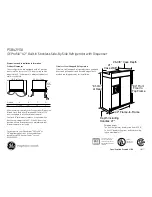
The freezer requires space around the casing for
efficient cooling and operation. The minimum
clearances are shown in Figure 9.
The freezer must be installed on a firm flat and
level surface for it to work quietly and efficiently.
If you wish to reverse the door refer to the section
above (pages 3 & 4).
Switching on
Plug the fridge/freezer into a nearby power socket
and switch on. The thermostat control (Figure 10) is
positioned inside the fridge by the light. Turn the
control to a half-way position on the dial and leave
the fridge/freezer running with the door closed for
approximately 2 hours. This will allow the inside
temperature to stabilise.
Temperature control – fridge
The temperature of the fridge is best maintained
around 0°C to + 5°C. Avoid setting the thermostat
too high otherwise this may reduce the temperature
to a point at which certain fresh foods may begin to
freeze. The temperature scale runs from 1, the
Page 5
FIGURE 9
FIGURE 10
Diagrams show alternative methods of providing correct air
flow around the appliance.
100 mm
25 mm
25 mm
100 mm
Installation and controls (cont)
warmest setting, to 5, the coldest. The 0 position is
an OFF setting which can be used when defrosting
the freezer. The fridge has an automatic defrost
cycle. Droplets of condensation or ice particles on
the back wall of the fridge are normal.
When storing food in the fridge keep food away
from the rear wall. To allow free circulation of cold
air don’t pack food too tightly on the shelves and
never put hot food in the fridge.
Temperature control – freezer
The thermostat position setting in the fridge
regulates the freezer temperature. The freezer
should be between –18°C and –28°C.
Leave the fridge/freezer to run for 12 hours before
freezing fresh food.
Notes on operation
During normal operation the following noises may
be heard:
O
O
Stifled murmur from compressor when it is
working.
O
O
Soft gurgling from the refrigerant flowing through
the cooling system.
O
O
Click from the thermostat switching on and off.
TEMPERATURE
CONTROL




























